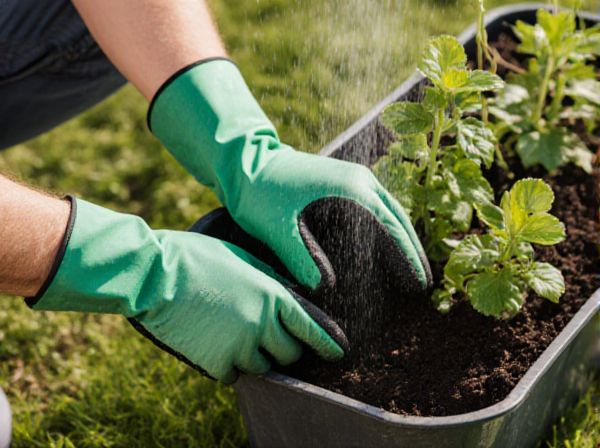
Sub-irrigated planter vs Drip irrigation containers Illustration
Sub-irrigated planters provide water directly to the plant roots through a reservoir at the base, minimizing water waste and promoting efficient absorption. Drip irrigation containers deliver water slowly to the soil surface, ensuring precise moisture control but often requiring more frequent maintenance. Both methods enhance plant health and water conservation, yet sub-irrigated systems are typically more self-sustaining and ideal for indoor gardening.
Table of Comparison
| Feature | Sub-Irrigated Planter | Drip Irrigation Container |
|---|---|---|
| Water Delivery | Water reservoir below soil for capillary action | Direct water delivery via drip emitters |
| Water Efficiency | High, reduces evaporation and runoff | Moderate to high, depends on emitter placement |
| Maintenance | Low, refill reservoir periodically | Moderate, check emitters for clogging |
| Plant Health | Consistent soil moisture levels | Targeted watering, risk of uneven moisture |
| Setup Complexity | Simple, integrated reservoir | Complex, requires tubing and emitters |
| Cost | Moderate initial cost | Higher initial cost due to equipment |
Introduction to Sub-Irrigated Planters and Drip Irrigation Containers
Sub-irrigated planters feature a built-in reservoir that delivers water directly to plant roots, reducing evaporation and promoting efficient water use. Drip irrigation containers utilize a network of tubes and emitters to provide controlled, targeted watering, minimizing runoff and soil erosion. Both systems enhance water conservation but differ in delivery method and maintenance requirements.
How Sub-Irrigated Planters Work
Sub-irrigated planters (SIPs) function by utilizing a water reservoir beneath the soil, allowing water to be absorbed directly through capillary action, which promotes efficient root hydration. This system minimizes water evaporation and reduces the frequency of watering compared to drip irrigation containers that deliver water from above the soil surface. The design of SIPs supports healthier plant growth by maintaining consistent soil moisture, optimizing water usage, and preventing overwatering and nutrient runoff common in traditional drip irrigation setups.
Mechanics of Drip Irrigation in Container Gardening
Drip irrigation in container gardening operates by delivering water directly to the root zone through a network of tubes and emitters, ensuring precise moisture control and minimizing water waste. This system maintains consistent soil moisture levels, promoting healthier root development and reducing the risk of overwatering or underwatering. Unlike sub-irrigated planters that rely on bottom-up wicking, drip irrigation allows for customizable watering schedules and is suitable for a variety of container sizes and plant types.
Water Efficiency: Sub-Irrigation vs Drip Systems
Sub-irrigated planters achieve higher water efficiency by delivering moisture directly to plant roots through a reservoir system, minimizing evaporation and runoff. Drip irrigation containers provide precise water distribution to the soil surface, reducing waste but tend to lose more water to evaporation compared to sub-irrigation. Studies show sub-irrigated systems can reduce water usage by up to 50% compared to conventional drip irrigation while maintaining consistent soil moisture levels.
Plant Health and Growth Outcomes
Sub-irrigated planters maintain consistent moisture levels by delivering water directly to the plant roots, reducing water stress and promoting healthier root development. Drip irrigation containers provide precise water delivery to the soil surface, allowing for controlled hydration but may require more frequent monitoring to avoid over- or under-watering. Studies indicate plants in sub-irrigated containers exhibit stronger growth and higher nutrient uptake efficiency compared to those using traditional drip irrigation systems.
Setup and Installation Comparison
Sub-irrigated planters require a reservoir setup that allows water uptake from the bottom, minimizing watering frequency and reducing runoff. Drip irrigation containers demand detailed installation of tubing and emitters to distribute water directly to the soil surface around plants, which may involve a timer for automated watering. The simplicity of sub-irrigated planters suits small-scale gardeners, while drip irrigation systems scale efficiently for larger container arrangements needing precise moisture control.
Maintenance Requirements and Longevity
Sub-irrigated planters typically require less frequent maintenance than drip irrigation containers due to their self-watering design, which reduces clogging and the need for constant monitoring. Drip irrigation containers demand regular inspection and cleaning of drip emitters to prevent blockages and ensure efficient water delivery, impacting their overall longevity. The durability of sub-irrigated planters often surpasses that of drip irrigation systems as fewer mechanical components reduce wear and tear over time.
Best Container Plants for Each System
Sub-irrigated planters excel with moisture-loving plants such as herbs like basil, mint, and lettuce, which thrive in consistently damp soil due to the self-watering reservoir design. Drip irrigation containers are ideal for drought-tolerant plants like succulents, tomatoes, and peppers, allowing precise water delivery to roots while preventing overwatering. Selecting plants compatible with each system ensures optimal growth, health, and water efficiency for container gardening.
Cost Analysis: Initial and Ongoing Expenses
Sub-irrigated planters have higher initial costs due to their built-in reservoir and wicking system, but they reduce ongoing water expenses by efficient moisture delivery. Drip irrigation containers generally involve lower upfront investment with a basic tubing setup, yet require continuous costs for drip emitters, maintenance, and water consumption. Over time, sub-irrigated planters offer cost savings in water and maintenance, while drip irrigation containers may incur higher recurring expenses despite lower starting costs.
Choosing the Right System for Your Container Garden
Sub-irrigated planters provide a self-watering system that minimizes water waste by allowing plants to draw moisture from a reservoir below the soil, ideal for consistent hydration with less maintenance. Drip irrigation containers deliver targeted water directly to the root zone through emitters, offering precise control over watering frequency and volume, which helps prevent overwatering and fungal issues. Choosing between these systems depends on your garden's size, plant types, and watering habits, with sub-irrigated planters suited for low-maintenance setups and drip irrigation preferred for customizable, larger container arrangements.
Sub-irrigated planter vs Drip irrigation containers Infographic

 gardendif.com
gardendif.com